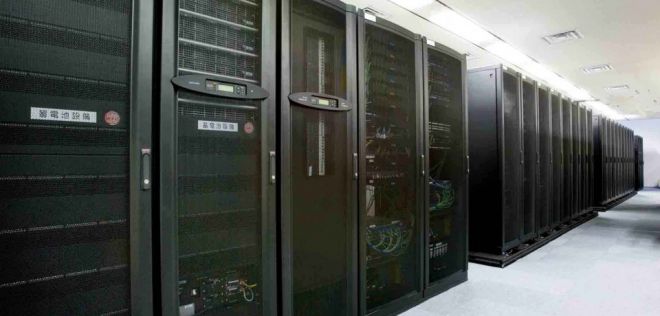Types of Data Centers: Steps to the Cloud
In our way to the cloud, we come across four types of data centers: the traditional data center, the highly virtualized data center, private cloud and public cloud. A hybrid cloud is a private cloud based data center connected to an outside (off-premise) data center; at a very minumum it is a combination of the private cloud with public cloud. Since we will cover both the public and the private clouds, we do not consider the hybrid cloud as a data center type.
Traditional Data Center
In the traditional data center model, we see many servers in big cabinets, each of them assigned to a different task(s) or application(s) and when redundancy is required, many servers are deployed for one task. In the traditional data center, a server is acquired, deployed and maintained individually. With the course of time, additional servers come with different hardware design and the data center administrators are faced with learning the new hardware characteristics. In addition, the servers, operating systems, applications have to be monitored and this brings different monitoring tools with additional knowledge required from the data center administrators. Updating and patching is also another issue because the updates have to be tested on different hardware and software environments to make sure that they will not affect the production systems. When all these costs are added up, there is need for high capital expenditures for acquiring systems and high operational expenditures for maintaining the systems. Even worse, the servers are underutilized delaying your return on investment. And finally, the cooling and powering cost of the data center is considerably high.
Today, most of us are working in such a data center.
Highly Virtualized Data Center
Many of these issues are addressed when companies stop looking at virtualization at a limited window and embrace it on wider basis. Try to accept virtualization as the basic foundation of your data center.
With this acceptance comes the concept of abstracting the software from the hardware.
With virtualization, you will definitely have fewer number of physical servers compared to the traditional data center because you will be running more servers on the same hardware. The hardware becomes a resource for virtualization. With the advancement of the blade servers and storage systems, the hardware layer becomes standard, and the concept of “servers” turn into a resource pool of processors, memory and storage area. Better, these resource pools can be used by more than one physical server. You are no longer assigning one server to one application or one task.
RELATED: Web Hosts Can’t Handle Holiday Donations to Non-Profits
To manage the infrastructure, you need fewer number of monitoring or management applications. The standardized hardware and monitoring and management applications mean less things to learn, easier patching and updating processes. The data center administrators can now turn their focus to how their data center functions. Since the management applications are consolidated, it means that they can provide more insights and can correlate more data.
Since there are less physical servers, you need less capital expenditures. In turn, you have a higher return on investment because you are utilizing more of your hardware resources. Fewer servers have fewer powering and cooling expenses. The lower carbon print is greener and overall it is cheaper.
Many of the corporations are moving (or have moved) to highly virtualized data centers.
Private Cloud
A private cloud is just a small step forward from the highly virtualized data center. A private cloud has all the features of the highly virtualized data center but it goes on with incorporating elasticity, self-service, rapid provisioning and measurability. The data center is no longer managed at the hardware level, but at the virtualization layer.
Private Cloud: The IT infrastructure is on company premises.
With private cloud, the IT undergoes a complete change. Provisioning of resources are no longer tied to the lengthy procurement processes of the company. With the new IT policies, even end users themselves can deploy resources by filling out the forms and defining their needs. This self-service provisioning brings agility to the company; the company can immediately react to the changing business environment. If the demand for resources have vanished and no longer needed, then with a couple of clicks the assigned resources can be returned to the resource pool. This is elasticity.
RELATED: Digital Erasers: The Next Big Money Maker
The maintenance windows and high availability concepts change dramatically. Since you can now deploy servers in a couple of minutes, it is another couple of minutes to provision the new server as a cluster resource for a critical application and achieve high availability. And since the systems are no longer tied to the underlying hardware, you can move the virtual server from one physical server to another, leave the physical server with no running virtual servers, patch, update, upgrade, restart it and assign the virtual servers back. The maintenance and downtime becomes virtually a thing of the past, bringing continuous availability instead of high availability.
The patching and updating of the servers become easier. In minutes you can build a test server that is of an identical configuration of the production server, apply updates, patches and fixes, test and then apply to the production environment. If you are having difficulty in maintaining different applications on the same server, you always have the choice of isolating the applications. This can be on the same virtual server with applying different virtualization solutions or on a different virtual server.
Finally, the datacenter use can completely be monitored. You can charge departments easily because their usage is metered in more detail and more objectively. This also makes budgeting process easier and provides a more realistic input for the future investments in the data center.
Public Cloud
Public Cloud: Cloud Provider hosts everything.
The public cloud is an extreme side of the cloud model. In this model you no longer have a data center. Since we have abstracted the software from the hardware, the hardware is no longer relevant; everything is about the application itself.
We no longer need to worry about the data center costs. What we are doing essentially is monitoring our Service Level Agreement (SLA.) We are no longer working task based; it is the cloud provider’s job to take care of the tasks. It is her duty to provide us the availability defined in our SLA.
RELATED: The Recent Cyber War: Who Won, Who Lost, and What Lessons Did We Learn?
On the IT professionals side, they have to measure the applications for load, health (isolation where necessary) and they have to manage identity, security, company policies etc.. The data center administrators daily tasks are significantly shifted to managing the cloud provider.
From the business side, the elasticity and agility have completely changed their meanings. Given the agreement with the cloud provider, the resources can be delivered 7/24 and the availability is continuous.
From the financial side, you no longer have the powering and cooling costs and no carbon footprint. The capital expenditures are virtually gone (still you need the basic infrastructure to connect to the public cloud), the capital expenditures are changed to the operational expenditures.
Hybrid Clouds
We cannot finish our article without touching the hybrid cloud. The hybrid cloud consists of both the private and the public cloud. To
Hybrid Clouds give you the best of the two world: host what you want to have on premises and outsource the rest to the public cloud.
think how this can be used, we can think about a company whose business is not software development and has an in-house web application that uses databases. Assume further that the software developers are company’s own employees. In the hybrid cloud model, the company can use the public cloud development environment (such as Microsoft Azure) but continue using its own data center for other IT tasks.
The hybrid cloud brings the best of two worlds together: it is the company’s choice about where to use the public cloud resources and where to use its own private cloud resources.
Finally, I think that the companies who need work with a data center will go for a hybrid cloud in the near future. Many companies will move completely to the public cloud as soon as they see the services offered match their expectations and compare the expenses – hosting their own versus purchasing the service.
The future is the cloud.




